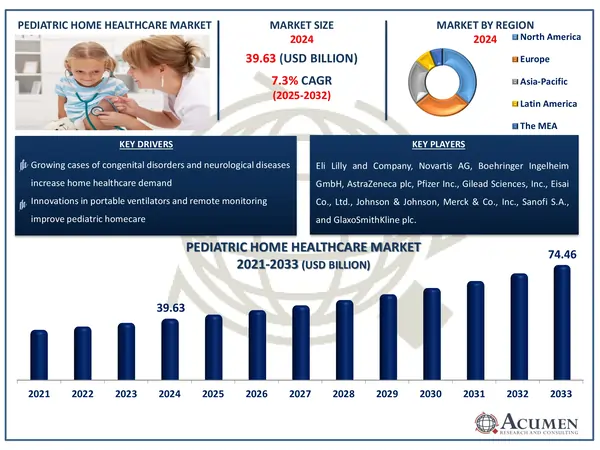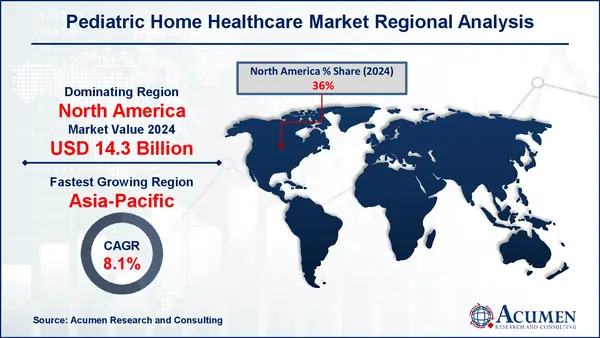September 2023
The Global Pediatric Home Healthcare Market Size accounted for USD 39.63 Billion in 2024 and is estimated to achieve a market size of USD 74.46 Billion by 2033 growing at a CAGR of 7.3% from 2025 to 2033.
The Global Pediatric Home Healthcare Market Size accounted for USD 39.63 Billion in 2024 and is estimated to achieve a market size of USD 74.46 Billion by 2033 growing at a CAGR of 7.3% from 2025 to 2033.

Home health care is a wide range of health care services that can be given at patient’s home for an injury or illness. Home health care services are usually convenient and just as effective as care patient get in a skilled nursing facility or hospital. The goal of the home health care is to regain independence, maintain current level of function, or to get better. Home health care can include broad range of care given by skilled medical professionals such as physical therapy, skilled nursing care, speech therapy, and occupational therapy. Home health care can also include skilled, non-medical care, such as medical social services or assistance with daily living from a highly qualified home health aide. Children born with medical complexities not only survive, they live their full lives at home rather than in a hospital. With the availability of advanced technologies to provide continuous care and medical assistance at home to these children is expected to fuel market growth. According to the Centers for Medicare and Medicaid Services (CMS), pediatrics is designated as the fastest-growing segment within home health care.
|
Market |
Pediatric Home Healthcare Market |
|
Pediatric Home Healthcare Market Size 2024 |
USD 39.63 Billion |
|
Pediatric Home Healthcare Market Forecast 2033 |
USD 74.46 Billion |
|
Pediatric Home Healthcare Market CAGR During 2025 - 2033 |
7.3% |
|
Pediatric Home Healthcare Market Analysis Period |
2021 - 2033 |
|
Pediatric Home Healthcare Market Base Year |
2024 |
|
Pediatric Home Healthcare Market Forecast Data |
2025 - 2033 |
|
Segments Covered |
By Service, By Application, By Care Provider, and By Geography |
|
Regional Scope |
North America, Europe, Asia Pacific, Latin America, and Middle East & Africa |
|
Key Companies Profiled Aviation |
Eli Lilly and Company, Novartis AG, Boehringer Ingelheim GmbH, AstraZeneca plc, Pfizer Inc., Gilead Sciences, Inc., Eisai Co., Ltd., Johnson & Johnson, Merck & Co., Inc., Sanofi S.A., and GlaxoSmithKline plc. |
|
Report Coverage |
Market Trends, Drivers, Restraints, Competitive Analysis, Player Profiling, Covid-19 Analysis, Regulation Analysis |
An increasing prevalence of children with special healthcare needs, rising awareness about home healthcare, technological advancement, and growing disposable income are the key factors to drive the market growth. The improvement in medical intervention procedures leads to increase in life expectancy of premature babies. This has further increases the demand for home pediatric care services. Premature infants and babies weighing less than 1 pound usually suffer from chronic conditions and require extra care from an early stage. Moreover growing cases of congenital disorders and neurological diseases increase home healthcare demand. For instance according to the WHO, every year, around 240,000 newborns globally die within 28 days of birth owing to congenital diseases. Congenital diseases account for an additional 170,000 fatalities among children aged one month to five years.
Favorable insurance policies responsible for the rising demand for pediatric home healthcare services. According to American Academy of Pediatrics published data, nursing care, personal care assistance, primary care, and hospice care at home for children are covered under Medicaid. Furthermore, majority of expenditure for pediatric care is covered by Medicaid and the remaining is covered by private insurance coverage. To improve the new born health, other developing countries are also providing funding for the pediatric home healthcare services. All these factors are likely to boost the market growth during the pediatric home healthcare market forecast period.
The worldwide market for pediatric home healthcare is split based on service, application, care provider, and geography.
According to pediatric home healthcare industry analysis, children need home health care services due to a chronic illness, an injury, or some medical complexity present at the birth. Hence, based on the service need, the market has been segmented into rehabilitation therapy services, personal care assistance, and skilled nursing services. In 2024, the rehabilitation therapy services segment accounted for the maximum share of the market and is expected to maintain its dominance during the forecast period. Large numbers of premature birth with muscular and neurological deficit across the world further need care at home is the key factor for the dominance of the segment.
Furthermore, presence of ample number of rehabilitation service providers such as speech therapy, occupational, and physical therapies for the pediatric population is responsible for accounting major share of the market. However, the skilled nursing services segment is anticipated to observe the significant growth during the forecast period. These services are necessary for children with complex medical conditions such as cystic fibrosis, cerebral palsy, epilepsy, and asthma. Skilled nursing services have significantly reduced inpatient cost of children and hence demand of services is continuously growing.
The respiratory disease category is predicted to have the highest revenue in the pediatric home healthcare market. This dominance is primarily due to the rising prevalence of chronic respiratory disorders among children, including asthma, bronchopulmonary dysplasia, and cystic fibrosis. The increased number of premature births, which frequently result in undeveloped lungs and long-term respiratory issues, increases demand for home-based respiratory care services.
Furthermore, advances in portable medical devices such as ventilators, nebulizers, and oxygen treatment equipment have made it possible for children with respiratory disorders to receive continuous care at home, eliminating the need for lengthy hospital stays. This not only improves patient comfort but also reduces healthcare expenses, making home healthcare a popular choice among families and healthcare professionals. Furthermore, favorable reimbursement regulations for home-based respiratory therapies, together with a growing preference for home care over hospital settings, boost the segment's revenue possibilities. As the global prevalence of pediatric respiratory illnesses increases, this category is projected to maintain its market lead.
In terms of pediatric home healthcare market analysis, the home healthcare agencies segment is the largest within care provider category. This segment hold around 32% share of the market and it is expected to grow throughout the forecast period due to the rising demand for specialized medical care at home. These organizations offer competent nursing, rehabilitative therapy, respiratory care, and personal help to pediatric patients with chronic illnesses, disabilities, and post-surgical needs. The growing preference for home-based treatment over hospital stays, combined with developments in medical technology, is driving this segment's rise. Furthermore, government programs and insurance coverage for home healthcare encourage uptake. Home healthcare organizations are the preferred choice for pediatric care due to their structured services, availability of skilled experts, and low cost.
North America
Europe
Asia-Pacific
Latin America
The Middle East & Africa

North America dominated the global pediatric home healthcare market in 2024 and is anticipated to observe its dominance during the forecast period. This can be attributed to the presence of awareness among parents, increasing number of complex conditions in infants, and availability of various providers in the U.S. Improvements in neonatal care has been result in a substantial decline in long-term morbidity from various chronic conditions following premature birth. Hence, various organizations are taking initiatives to increase pediatric care at home. However, low reimbursement is anticipated to limit the growth of the market. For instance according to the Centers for Disease Control and Prevention, cigarette smoking is responsible for approximately 480,000 fatalities annually in the US, and over 16 million Americans suffer from smoking-related diseases.
The Asia-Pacific is expected to observe the fastest growth during the pediatric home healthcare market forecast period. This can be attributed to rising awareness, entry of various market players, and significantly improved survival expectancy of neonatal babies and premature infants due to growing adoption of advanced medical technologies. These premature infants are at higher risk of developing neurological and physical disorders, requiring home pediatric care.
Some of the top pediatric home healthcare companies offered in our report include Eli Lilly and Company, Novartis AG, Boehringer Ingelheim GmbH, AstraZeneca plc, Pfizer Inc., Gilead Sciences, Inc., Eisai Co., Ltd., Johnson & Johnson, Merck & Co., Inc., Sanofi S.A., and GlaxoSmithKline plc.
Looking for discounts, bulk pricing, or custom solutions? Contact us today at sales@acumenresearchandconsulting.com
September 2023
June 2021
August 2018
February 2025